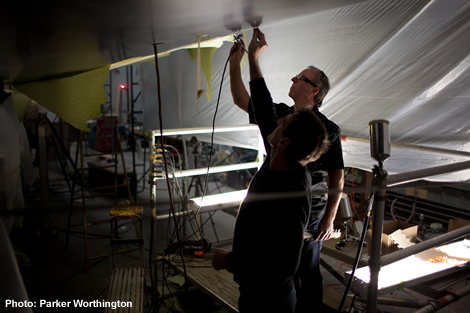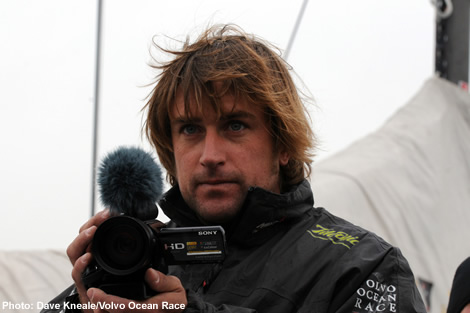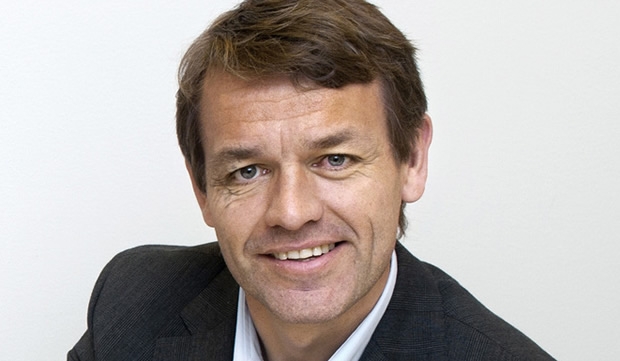Volvo Ocean Race update
Just over seven months to go now until the start of the Volvo Ocean Race. At present six boats are set to be on the start line with new boats from Puma, Groupama, Camper (Team NZ), Abu Dhabi and a Spanish team, yet to be announced for some reason. Currently training out of Vigo, the mysterious Spanish team are also planning to field Telefonica Blue in this year's event.
Ideally they would like two more teams, says VOR CEO Knut Frostad, but as yet there is no news. “We have a couple in the pipeline and we are working very hard with them. It is taking a bit more time, but we are making some progress.”
He points out that in fact at present they are exactly where they were this time before the start of the last race with six fully funded teams, Green Dragon only finding their main sponsor in May as the same time as Ger O’Rourke came in with what would become the Delta Lloyd campaign.
“The key thing for us is the quality of the teams and going into the future with this race, that is our strategy - we want it to be the race for the best sailors and as it is quite costly to do the race there isn’t really room for a huge amount of teams. Quality-wise, the top five teams we have I think on average are on a higher level than we have ever had before. That will prove to be a very good fight among the top five, probably stronger any other racing than I’ve seen for a long time.”
Last week saw was the cut-off date for the teams in terms of training on their old boats. Next up is the launch of the new boats which will take place from the end of this month into May, with the first (to emerge from the shed at least) expected to be Chris Nicholson’s Marcellino Botin-designed Camper down in New Zealand. Meanwhile among the three Juan K designs, Groupama’s new boat is in build at Multiplast in France, Puma at New England Boatworks in Rhode Island, the Spanish boat is in built in Valencia and Abu Dhabi Ocean Racing’s Farr design is in build at Persico in Italy.

So what does Frostad expect the latest generation VO70s will be like? “I haven’t seen them joined together, but they are all saying there is going to be ‘wow factor’ to it. Also the fact that all three designers have a good track record now with VO70s, it will be interesting to see the differences.”
He reckons, and its not exactly going out on a limb here, that the new Juan K designs will be a development of the last race winner, Ericsson 4, with a similar hull shape with a lot of buoyancy in the bows and plenty of form stability. But as each of the three teams involves has their own individual design teams working in conjunction with the Argentinian maestro Frostad reckons their layouts on deck will vary. “And there could be a few things driven by the rule – like you can’t stack inside the stern, that has changed a few thing.”
With the Camper project they are running, Frostad says he knows that Team New Zealand put the might of their America’s Cup design team into the Volvo project while the hiatus over the America’s Cup was taking place. Puma has many of the talented Kiwi brains trust from ABN AMRO One/Ericsson 4 involved with it, the Brad Jacksons and Tony Mutters, while Farr Yacht Design are gunning hard to pen this time’s race winner having been roundly beaten by Juan K in the last two events.
“I am hoping that the best boats from the last race will be up there and to see the differences will be interesting as well,” continues Frostad. “If they all end up going in the corner of fat form stability boats that need a bit of breeze to start going, it will be interesting to see if a boat like Telefonica Blue, could be in a different corner and win say win the parts of the race in lighter wind, upwind and the in-port races, etc.”

Tour of the piracy hotspots
A significant issue for the next race is its foray into the Indian Ocean, which now seems to ‘belong’ mostly to Somali pirates.
From Somalia on the south side of the Gulf of Aden (on the northwest side of the Indian Ocean), the reach of Somali pirate attacks in 2010 spanned up to more than 1000 miles from home, leaving a ‘safe’ corridor about 200 miles wide up the west coast of India. Obviously a group of racing yachts emblazoned brightly with the names of major retail brands would present potentially rich pickings for pirates as the Volvo Ocean Race fleet head towards the Gulf and the stopover in Abu Dhabi over Christmas this year and then back out into the Indian Ocean and on to Sanya, China in mid-January.
The Volvo Ocean Race organisers have been taking this threat extremely seriously for some time now, particularly those that have occurred over the last months to yachts and their crews, culminating in the most horrific killing of the four crew aboard the American yacht Quest in this area just one month ago.
“I think we have a pretty good picture of why that happened and how we could have avoided those three or four scenarios that have happened in the last 12 months,” says Frostad. “I think we could have avoided at least being in the same position georgraphically as they were.
He adds: “We are monitoring it all the time. We have our contingency plans and strategies. We are working with professional advisors. We are not trying to become pirates experts ourselves. The first thing for us is obviously to try as much as possible and avoid the problem, to the extent that that is possible.”
Frostad reminds us that Somali piracy was also an issue in the last Volvo Ocean Race when the course for leg two from Cape Town to Cochin in India included an ‘East Africa exclusion zone’ to the west of 58degE. As an indication of how the reach of the piracy threat has extended since then, the eastern-most reported attacks last year were as far east as 69degE.
“We are obviously going to do the same thing as much as it is possible to do,” continues Frostad. “Obviously if the pirates start to close the whole Indian Ocean, we have a problem, but at the moment we are monitoring it and we are getting advice.”
The Volvo Ocean Race are working closely with a number of companies, government and international agencies and militaries, maritime organisations and nondescript ‘other bodies’ to gain the best possible picture of the situation and what might be done. However for various reasons Frostad says they can’t make a decision now and even if they did, it would not be made public.
“We don’t know what it is going to look like when we are there, but we have flexibility in the Volvo Ocean Race rules that we can change anything we like at any given time in the race. We obviously won’t release now where we are going to sail and in particular we won’t tell the pirates where we are going to sail. We will see what the situation is when we are there.”
Numerous options exist. One is to race the boats up the safe corridor off western India within Indian territorial waters (most of the attacks take place in international waters). Alternatively they stop the leg short and sail the boats to Abu Dhabi in convoy with ‘assistance’ available from both the military or other ‘independent contractors’ (to use the CIA term).
“If we can get an escort through that part of the world that could help, but it is not easy to do," says Frostad. "We have been in discussions already and we have looked at options over the last two years, but it hasn’t proved feasible yet because you have to have the fleet very close together to make a difference. And obviously it is expensive and it is not very environmentally friendly to send a big ship around trying to catch up with our boats. But there are private companies who do that and they have offered their services to us and we have been in discussion with them.” Frostad adds that this is unlikely to be an option.
Another possibility would be for the yachts to carry arms on board, but Frostad says this is completely out of the question. “All the professional advisors we have, say that is a no-no.”
Obviously if the situation escalates and the reach of the pirates extends all the way across to India, effectively blocking off the whole of the Indian Ocean, then there is the possibility that the Abu Dhabi stopover would have to be cancelled outright, with potential consequences for Ian Walker’s team which heralds from there. According to Frostad they have the option within the VOR rules to choose any of these options when the time comes. “Obviously we rely on advice. If we get advice to not go here or not go there, then we won’t go there.”
While the greatest threat of piracy comes from Somalia, in fact the route of both this Volvo Ocean Race and the last is unconsciously something of a worldwide tour of the international piracy hotspots.
Frostad points to the coast of Brazil which Sodebo and the Barcelona World Race leaders have just passed, his friend Thomas Coville passing within spitting distance of the Brazilian beach last week. “I know of three big piracy attacks off the Brazilian coast and Venezuela.”
With the race now going to the Far East inevitably boats just pass through Malacca Strait between Malaysia and the main Indonesian island of Sumatra which until the rise of the situation off Somalia was the world’s top piracy hot spot. “Then we have the whole area around the southeast coast of China, the north coast of Indonesia, around Sri Lanka and around South America.”
En route to Abu Dhabi, the race course is also close to Iranian and we all remember what happened in December 2009 when the Pindar Whitbread 60 happened to stray too close... Plus with uprisings aplenty in the Middle East at present Frostad says it is hard to determine what the political landscape there will look like come December-January time. “Running round the world races has never been straightforward. And then you have the whole thing happening in the Middle East now.”

Media
While the next ports/teams conference is coming up next week, Frostad says they have been making good process moving ahead with the TV product for the next Volvo Ocean Race. “You will see a big change in how it is going to be done on board, the equipment we are using and what kind of programming we are going to present and how the event is being consumed by the average person who is not necessarily a sailing person. That is where we have the biggest potential gain.”
Frostad says that while they have developed the on-board camera side of their technology the biggest step forward this time is with the on-board audio; both ambient sound from the boat and also having the crew mic’ed up. “We can have microphones on all the sailors and will be able to record that at any given time in good enough quality. I hope that will make a big change to the video material.” Crews will have to mind their ps and qs...
They are also looking to change their strategy when it comes to the kind of programme they want to produce. “Over the last three races we have always tried to speak the same language to everybody and that doesn’t really work because you try to make it work for the man in the street who is not a sailor so you talk that language, but that doesn’t do it for the sailors and the sports fans. So you end up not winning anybody.”
This time there will be two separate sets of TV programs catering for these groups, one being the hardened sailors and sports enthusiasts, including more live production, racing coverage, while the other is more touchy-feely feature-style, about the families and shore side. “They might even end up on different TV channels,” says Frostad. “That is a key for us because one of the big things an ocean race has is the adventure aspect which means you can tap into a much bigger audience than you can with an inshore racing class.”











Latest Comments
Add a comment - Members log in